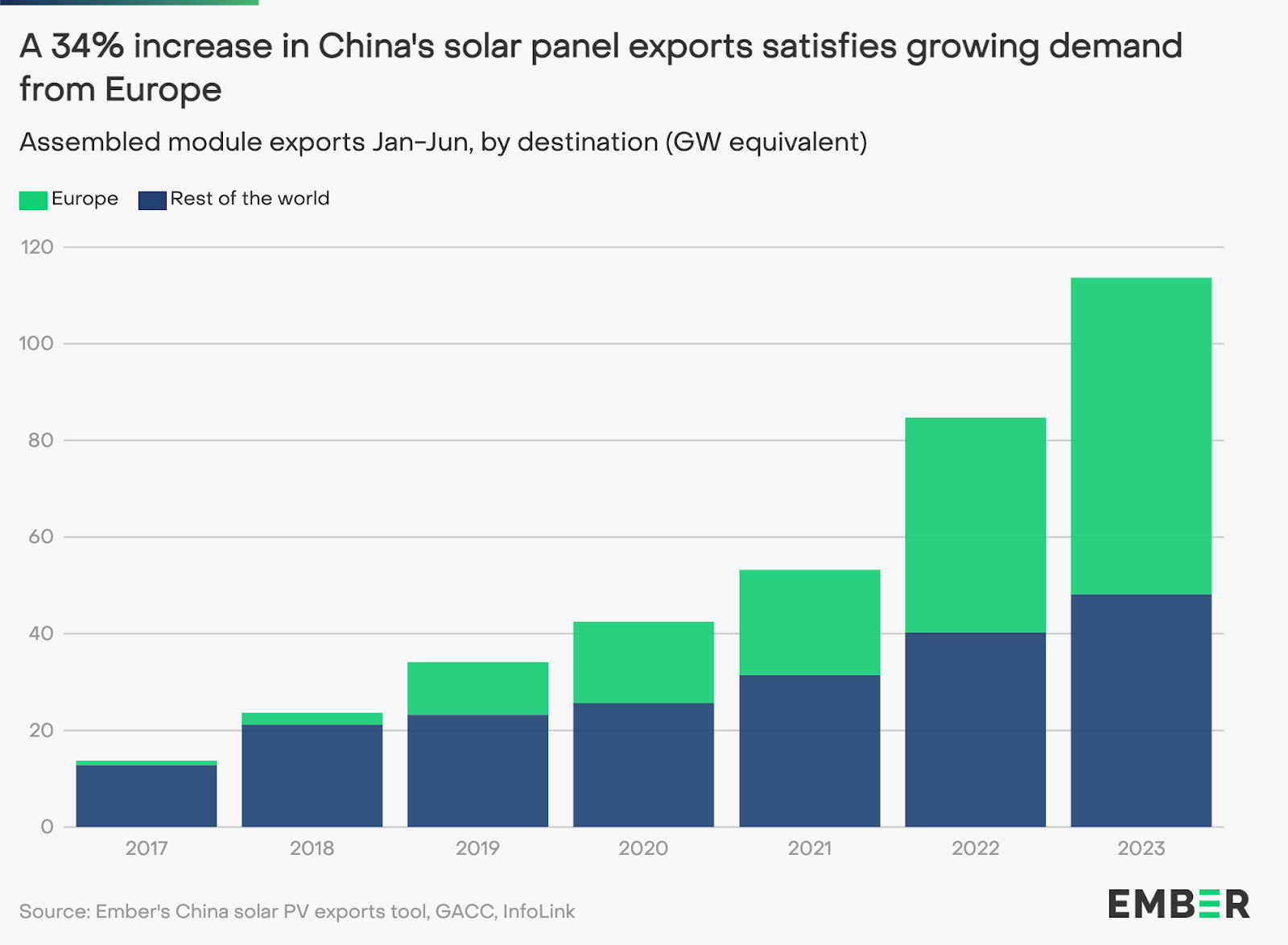A 34% increase in China’s solar panel exports meets growing global demand
-
London
-
14 September 2023
New analysis by energy think tank Ember finds that exports of solar panels from China grew by 34% in the first half of 2023, with 114 GW shipped worldwide, compared to 85 GW in the same period last year. Europe saw the largest absolute increase, while Africa saw the largest percentage growth.
“Solar growth is going through the roof,” said Sam Hawkins, Ember’s data lead. “The world is racing to harness this cheap, clean and abundant source of energy to power the future economy. It is clear that global manufacturing capacity is currently not the limiting factor to achieving the required fivefold growth in solar power by 2030.”
The latest report analyses Chinese export data and releases a new dataset providing up-to-date monthly data for every destination country. Representing around 80% of the global market share in solar manufacturing capacity, the growth in Chinese exports has global implications for the scale-up of clean power.
More than half of the solar modules exported from China in the first half of 2023 were destined for Europe (52.5%). The region also saw the greatest absolute growth worldwide, with exports from China up 47% year-on-year (+21 GW), reaching a total of 65 GW shipped in the first half of 2023, compared with 44 GW in the same period last year. Once installed, this new capacity could provide around 2% of Europe’s annual electricity demand, similar to the demand of Belgium, supporting the region’s goals to increase energy independence.
Brazil is the next biggest importer after Europe, importing 9.5 GW in the first six months of 2023, a similar amount to the same period last year (9.4 GW). However, the fastest growth is happening across Africa and the Middle East.
South Africa saw the largest change in any country outside of Europe, importing 3.4 GW of solar panels from China in the first six months of 2023, an increase of 438% (+2.7 GW) compared to the same period last year. As a result, Africa was up 187% (+3.7 GW), the fastest-growing region.
After Africa, the region with the next fastest relative growth was the Middle East, up 64% (+2.4 GW) in the first half of 2023 compared to the same period last year. However, the high growth rates are in the context of a very low starting point. Saudi Arabia increased solar imports from China sixfold year-on-year to reach 2.8 GW in the first half of 2023, while the United Arab Emirates increased imports by 33% to 1.4 GW.
The only region to see fewer imports from China over the period was Asia, as India turned to focus on growing domestic manufacturing capacity.
Solar installations not keeping pace
With global manufacturing capacity expected to double again by the end of 2024 compared to the end of 2022, as other countries outside China also step up domestic manufacturing, global supply of modules is not a bottleneck to accelerated solar growth. However, the gap between solar module exports and installed PV capacity is widening, which in part reflects a buildup of module stocks in warehouses and the challenges of ramping up the installation and grid integration of solar generation.
Sam Hawkins Data lead, Ember
We have enough solar panels, we just need to get busy installing them. Policies should focus on ensuring installation and grid integration can ramp up as fast as global module supply.
Notes to editors
The analysis will be published at 00.01 on Thursday 14th September at the following link:
ember-climate.org/insights/research/china-solar-exports
Media Pack – including the press release, report, chart images and data file
Media enquiries
About Ember
Ember is an independent energy think tank that aims to accelerate the clean energy transition with data and policy. It creates targeted data insights to advance policies that urgently shift the world to a clean, electrified energy future.

